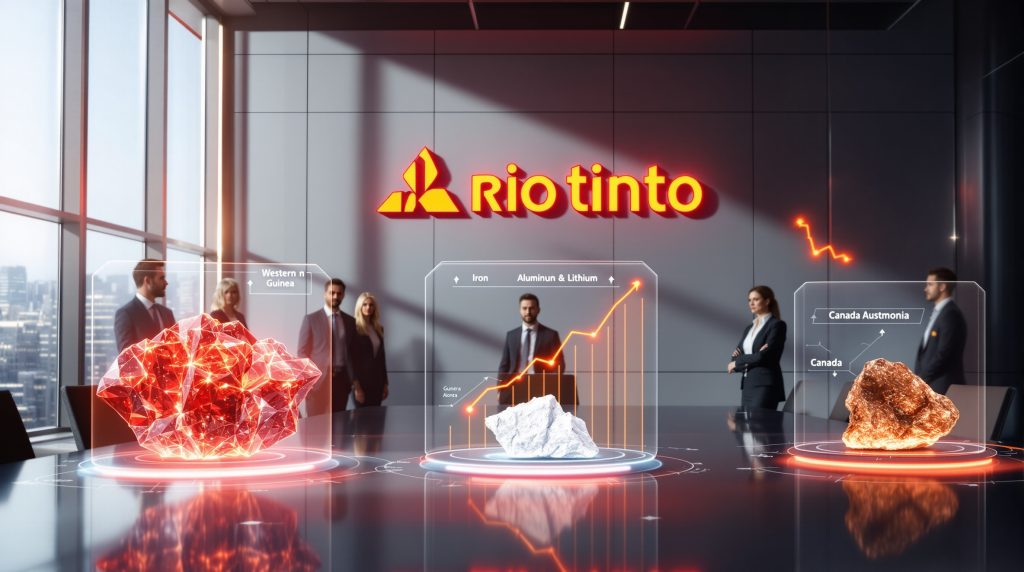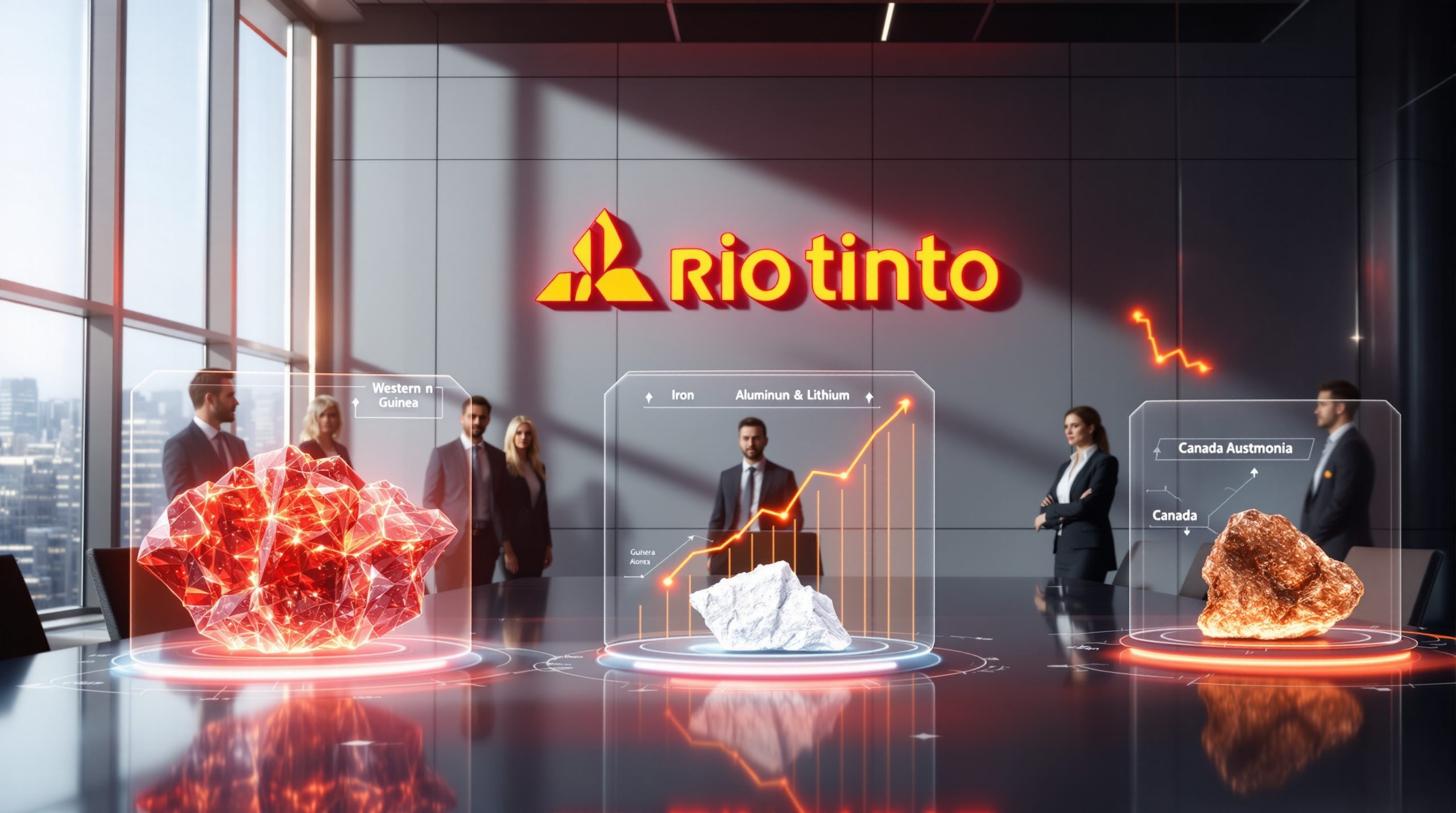Rio Tinto's Strategic Transformation: New Operating Model and Leadership Structure
How Is Rio Tinto Restructuring Its Business Operations?
Rio Tinto has unveiled a comprehensive reorganization of its operating model, consolidating its diverse portfolio into three streamlined business units. This strategic shift aims to enhance accountability, improve operational efficiency, and position the company to capitalize on growth opportunities in key mineral markets.
The Three-Pillar Business Structure
The mining giant has simplified its product group structure to focus on three core businesses:
- Iron Ore
- Aluminium & Lithium
- Copper
This consolidation represents a significant departure from the previous more fragmented organizational approach, creating clearer lines of responsibility and enabling more agile decision-making processes across the company's global operations.
Strategic Rationale Behind the Restructuring
The reorganization addresses several business imperatives:
- Streamlining operations to reduce organizational complexity
- Enhancing accountability at leadership levels
- Improving capital allocation efficiency
- Accelerating decision-making processes
- Leveraging cross-business synergies and knowledge sharing
- Focusing resources on highest-return opportunities
According to CEO Simon Trott, this simplified structure is "grounded in our fundamental commitment to safety and with sharper focus on the most compelling opportunities we have," which will "enable us to deliver new standards of operational excellence and value creation" (Rio Tinto Press Release, August 29, 2025).
What Changes Are Happening to Rio Tinto's Iron Ore Business?
Creation of a Unified Global Iron Ore Portfolio
The new Iron Ore product group consolidates all of Rio Tinto's iron ore assets under a single leadership structure, bringing together:
- Western Australian Iron Ore operations
- Iron Ore Company of Canada
- The Simandou project in Guinea (upon completion)
This integration creates a truly global iron ore business with operations spanning three continents, enabling more consistent operational practices and technology deployment across diverse geographies.
Leadership and Strategic Direction
Matthew Holcz has been appointed Chief Executive Iron Ore, bringing over two decades of international mining experience to the role. His leadership will focus on:
- Implementing consistent safety standards across all operations
- Transferring operational best practices between established and developing assets
- Deploying cutting-edge technologies uniformly across the portfolio
- Strengthening community partnerships across diverse operating regions
CEO Trott highlighted Holcz's extensive experience, noting he "currently oversees 18 mines" in the Pilbara region and is "a role model for Rio Tinto's values" who will "drive safety standards, performance, and strong partnerships with communities, in our largest global business" (Rio Tinto Press Release, August 29, 2025).
The Simandou Integration Strategy
The inclusion of the Simandou project within this unified structure represents a forward-looking approach to portfolio management, allowing Rio Tinto to:
- Apply established operational expertise to new development projects
- Transfer technological innovations between mature and emerging operations
- Create a more balanced geographic footprint in iron ore production
- Establish consistent environmental and community engagement practices
The company emphasizes this will "combine the proven performance of the company's established Iron Ore operations with the potential of Simandou, sharing safety best practices, cutting-edge technologies and operational experience across the entire Iron Ore portfolio to create an even stronger global business" (Rio Tinto Press Release, August 29, 2025).
How Is Rio Tinto Positioning Its Aluminium and Lithium Operations?
The Combined Aluminium & Lithium Product Group
Under the leadership of Jérôme Pécresse, Rio Tinto has merged its Aluminium and Lithium businesses into a single product group comprising three distinct operational segments:
- Atlantic Operations Aluminium
- Pacific Operations Aluminium
- Lithium
This consolidation creates a business unit focused on materials with significant processing requirements and downstream market exposure, leveraging shared technical capabilities and market relationships.
Strategic Synergies in Processing and Technology
The integration of these businesses leverages several operational synergies:
- Shared processing expertise between aluminium and lithium operations
- Unified deployment of the Safe Production System across all facilities
- Coordinated downstream market development strategies
- Consolidated technical innovation programs
- Streamlined capital allocation between related business units
The company describes this as "a streamlined structure, bringing together businesses centred on processing capability and downstream exposure" (Rio Tinto Press Release, August 29, 2025).
Lithium Growth Strategy
The inclusion of lithium within this product group signals Rio Tinto's commitment to expanding its presence in battery metals, with a focus on:
- Accelerating development of lithium assets
- Leveraging processing expertise from aluminium operations
- Positioning for growth in electric vehicle and energy storage markets
- Developing integrated supply chain relationships with battery manufacturers
According to the company, this integration enables "the shared deployment of productivity initiatives, such as the Safe Production System, which have been a key driver of improved performance in the Aluminium business" (Rio Tinto Press Release, August 29, 2025). Furthermore, ongoing lithium industry innovations are likely to benefit from this consolidated approach.
What Is Rio Tinto's Strategy for Its Copper Business?
Copper's Central Role in Energy Transition
The Copper product group, led by Katie Jackson, remains a standalone business unit focused on capitalizing on growing demand driven by global electrification and renewable energy deployment. With increasing concerns about the global copper supply forecast, this strategic focus is particularly timely.
Key Strategic Priorities
The Copper business is focusing on several critical initiatives:
- Successful ramp-up of the Oyu Tolgoi underground operation in Mongolia
- Stabilization of operations at the Kennecott mine in Utah
- Advancement of the Resolution Copper project in Arizona
- Development of strategic partnerships such as Nuevo Cobre in Chile
The company describes Copper as "well positioned to capitalise on the global energy transition" with a focus on "the successful ramp up of Oyu Tolgoi, the stabilising of Kennecott and advancing future options, including the Resolution project in the USA and partnerships such as Nuevo Cobre in Chile" (Rio Tinto Press Release, August 29, 2025).
Market Positioning and Growth Trajectory
Rio Tinto is strategically positioning its copper business to:
- Capitalize on projected copper demand growth from electrification
- Establish a balanced portfolio of operating and development assets
- Secure long-term production growth through strategic partnerships
- Implement innovative mining and processing technologies
This positioning acknowledges the critical role copper will play in global decarbonization efforts and positions Rio Tinto to benefit from increasing demand for this essential metal.
What Leadership Changes Accompany Rio Tinto's Restructuring?
Executive Team Realignment
The organizational restructuring has triggered significant changes to Rio Tinto's executive leadership team:
- Simon Trott continues as Chief Executive Officer
- Matthew Holcz appointed as Chief Executive Iron Ore
- Jérôme Pécresse leads the combined Aluminium & Lithium business
- Katie Jackson continues leading the Copper business
- Bold Baatar, Chief Commercial Officer, assumes oversight of Borates and Iron & Titanium businesses during strategic review
This realignment creates a more focused executive team with clear accountabilities for the core business units.
Notable Leadership Transitions
The reorganization has resulted in several significant leadership changes:
- Sinead Kaufman, who held senior leadership roles over nearly 30 years with Rio Tinto, will depart the company in October 2025
- The Chief Executive Australia role, previously held by Kellie Parker, will conclude with responsibilities transitioning to a new head of Australia position
- Parker will remain during a transition period reporting to CEO Simon Trott
CEO Trott praised Kaufman's contributions, noting she "joined Rio in 1997 as a geologist in the UK and has built an exceptional career, holding senior leadership roles across a range of commodities, including leading our divestment from coal and establishing our lithium operations" (Rio Tinto Press Release, August 29, 2025).
Leadership Philosophy and Accountability
The restructured leadership team reflects Rio Tinto's emphasis on:
- Clear accountability for operational performance
- Streamlined decision-making processes
- Enhanced focus on safety and sustainability
- Disciplined capital allocation
- Strengthened stakeholder engagement
Regarding Parker's transition, Trott acknowledged she "has been a transformational leader through a challenging period for Rio Tinto in Australia, setting us on a path towards being a better partner to the communities in which we operate" during her 24 years with the company (Rio Tinto Press Release, August 29, 2025).
What Strategic Review Is Underway for Non-Core Assets?
Assets Under Strategic Assessment
Rio Tinto has moved its Borates and Iron & Titanium businesses to the Chief Commercial Officer's portfolio for comprehensive strategic review, signaling potential portfolio optimization. This approach aligns with broader industry consolidation insights that suggest strategic rationalization is becoming increasingly common.
Review Process and Timeline
The strategic assessment will:
- Evaluate the strategic fit of these businesses within Rio Tinto's portfolio
- Assess their growth potential and capital requirements
- Consider potential divestment opportunities
- Determine optimal ownership structures to maximize value
The company has committed that "an update will be provided on the outcome of these reviews in due course" (Rio Tinto Press Release, August 29, 2025).
Operational Continuity During Review
Throughout the strategic review process, Rio Tinto has emphasized that these businesses will:
- Maintain safety as the top priority
- Continue meeting customer commitments
- Focus on profitable operations
- Pursue operational improvements
The company specifically noted that "throughout this review process, these businesses will continue to focus on running safely and profitably to meet customer commitments" (Rio Tinto Press Release, August 29, 2025).
How Will This Restructuring Impact Rio Tinto's Performance?
Expected Operational Benefits
The simplified organizational structure is anticipated to deliver several performance improvements:
- Enhanced operational efficiency through streamlined management
- Improved capital allocation through clearer investment prioritization
- Accelerated decision-making through reduced organizational layers
- Greater knowledge sharing across similar operations
- More consistent implementation of safety and productivity initiatives
CEO Trott emphasized this will bring "greater accountability and focus to our teams, underpinned by a more disciplined approach to operational performance and capital investment" (Rio Tinto Press Release, August 29, 2025).
Financial Performance Expectations
While specific financial targets haven't been disclosed, the restructuring aims to:
- Reduce overhead costs through organizational simplification
- Improve capital efficiency through more disciplined investment processes
- Enhance returns through focusing on highest-value growth opportunities
- Strengthen resilience against commodity price volatility
- Create sustainable long-term shareholder value
The company notes it has "delivered resilient results this year, remain on track to deliver strong mid-term production growth" and will focus on "unlocking further shareholder value, putting both our capital and talent where it will deliver the greatest returns" (Rio Tinto Press Release, August 29, 2025). The iron ore price forecast will likely play a significant role in determining the success of these financial outcomes.
Measuring Success
The effectiveness of the restructuring will likely be measured against several key performance indicators:
- Safety performance across all operations
- Production volumes and unit cost improvements
- Capital allocation efficiency
- Project delivery performance
- Total shareholder returns
The company's commitment to "continue to make progress against our objectives" suggests ongoing performance measurement against established strategic goals (Rio Tinto Press Release, August 29, 2025).
What Does This Restructuring Reveal About Rio Tinto's Long-Term Strategy?
Strategic Priorities Emerging from the Reorganization
The restructuring highlights several key strategic priorities for Rio Tinto:
- Portfolio Optimization: Focusing on core commodities with strong long-term demand fundamentals
- Operational Excellence: Enhancing productivity and safety across all operations
- Capital Discipline: Ensuring investments deliver appropriate returns
- Growth Focus: Prioritizing development in iron ore, copper, and battery materials
- Sustainability Leadership: Maintaining industry-leading environmental and social performance
These priorities reflect a balanced approach to near-term performance improvement and long-term value creation. According to mining industry innovation experts, this type of structural realignment is becoming increasingly common in the sector.
Commodity Market Positioning
The reorganization reveals Rio Tinto's strategic view on key commodity markets:
- Iron Ore: Maintaining leadership while developing new high-quality resources
- Aluminium: Leveraging low-carbon production capabilities in a decarbonizing world
- Lithium: Expanding presence in battery materials markets
- Copper: Positioning for growth in electrification-driven demand
- Non-Core Assets: Evaluating strategic options for optimizing portfolio value
This positioning aligns with broader energy transition trends and highlights Rio Tinto's focus on materials essential for decarbonization.
Competitive Positioning
The restructuring positions Rio Tinto to:
- Compete more effectively against major diversified miners
- Respond more nimbly to changing market conditions
- Allocate capital more efficiently to highest-return opportunities
- Leverage operational expertise across similar business units
- Maintain cost competitiveness through simplified structures
This strengthened competitive positioning should enable Rio Tinto to capture greater value from its asset portfolio and respond effectively to evolving market dynamics.
What Are the Implications for Stakeholders?
Shareholder Value Proposition
For investors, the restructuring signals:
- Enhanced focus on operational performance and capital returns
- Clearer strategic direction in core commodities
- More disciplined approach to growth investments
- Potential portfolio optimization through non-core asset reviews
- Simplified business structure for easier performance assessment
These changes align with shareholder expectations for improved capital discipline and returns-focused growth.
Employee Impact
The organizational changes will affect Rio Tinto's workforce through:
- Redefined reporting structures and accountabilities
- Potential rationalization of overlapping functions
- New career development pathways within streamlined business units
- Enhanced knowledge sharing across similar operations
- Clearer alignment between individual roles and strategic priorities
While some leadership positions will be eliminated, the restructuring creates opportunities for talent development within more focused business units.
Community and Government Relations
The restructuring includes changes to Rio Tinto's approach to external stakeholder engagement:
- Transition of the Chief Executive Australia role to a new head of Australia position
- Continued focus on being a responsible community partner
- Maintaining strong government relationships across operating jurisdictions
- Consistent application of sustainability standards across all operations
The company's restructuring of its Australia leadership suggests an evolution in its approach to stakeholder engagement while maintaining its commitment to community partnerships.
How Does This Compare to Industry Trends?
Mining Industry Restructuring Context
Rio Tinto's reorganization reflects broader industry trends toward:
- Simplification of corporate structures
- Focus on core commodities with strong fundamentals
- Portfolio optimization through strategic reviews and divestments
- Enhanced operational efficiency through organizational streamlining
- Balancing established operations with future growth opportunities
These trends have been evident across the mining sector as companies adapt to evolving market conditions and investor expectations.
Competitive Landscape Implications
The restructuring positions Rio Tinto relative to major competitors by:
- Creating clearer commodity-focused business units similar to BHP's model
- Enhancing operational focus compared to more diversified miners
- Streamlining decision-making processes for greater agility
- Maintaining scale advantages in key commodities like iron ore
- Positioning for growth in energy transition materials
This positioning strengthens Rio Tinto's ability to compete effectively in its core markets while developing new growth opportunities.
Alignment with Market Expectations
The changes align with market and analyst expectations for:
- Greater operational discipline and efficiency
- Enhanced capital allocation processes
- Portfolio rationalization of non-core assets
- Focused growth in commodities with strong demand fundamentals
- Simplified organizational structures with clear accountabilities
This alignment should support positive market reception of the restructuring initiative and its expected outcomes.
What's Next for Rio Tinto?
Implementation Timeline and Milestones
The restructuring implementation involves several key phases:
- Immediate organizational structure changes (already implemented)
- Leadership transitions through October 2025
- Strategic review of non-core assets with updates expected in coming months
- Gradual integration of operational practices across unified business units
- Ongoing refinement of capital allocation processes
This phased approach ensures operational continuity while implementing structural changes.
Future Growth Focus Areas
Based on the restructuring, Rio Tinto appears focused on growth in:
- Iron Ore: Developing the Simandou project in Guinea
- Copper: Ramping up Oyu Tolgoi and advancing Resolution Copper
- Lithium: Expanding presence in battery materials
- Aluminium: Leveraging low-carbon production advantages
These focus areas align with projected demand growth in materials essential for global development and the energy transition.
Potential Challenges and Risks
The successful implementation of the restructuring may face challenges including:
- Managing organizational change while maintaining operational performance
- Ensuring consistent safety standards across consolidated business units
- Navigating potential divestments of non-core assets
- Balancing short-term performance with long-term strategic investments
- Maintaining strong stakeholder relationships during transition periods
Addressing these challenges will be critical to realizing the full benefits of the restructuring initiative.
Streamlined Rio Tinto for the Future
Rio Tinto's organizational restructuring represents a comprehensive effort to position the company for sustainable growth in a rapidly evolving mining industry. By consolidating operations into three focused business units, streamlining leadership, and reviewing non-core assets, the company aims to enhance accountability, improve operational performance, and create additional shareholder value.
The changes reflect a strategic vision centered on operational excellence, disciplined capital allocation, and focused growth in commodities essential to global development and the energy transition. As implementation progresses, stakeholders will be watching closely to see how these structural changes translate into improved performance and returns.
Key Takeaways: Rio Tinto's Restructuring
| Business Unit | Leadership | Key Assets | Strategic Focus |
|---|---|---|---|
| Iron Ore | Matthew Holcz | Western Australian operations, Iron Ore Company of Canada, Simandou (future) | Unified operational practices, technology deployment, safety standards |
| Aluminium & Lithium | Jérôme Pécresse | Atlantic Operations, Pacific Operations, Lithium business | Processing synergies, Safe Production System, downstream market development |
| Copper | Katie Jackson | Oyu Tolgoi, Kennecott, Resolution (development), Nuevo Cobre partnership | Energy transition positioning, production stabilization, project advancement |
| Under Review | Bold Baatar (oversight) | Borates, Iron & Titanium | Strategic assessment of fit within portfolio |
Disclaimer: This analysis is based on Rio Tinto's announcements as of August 29, 2025. Future performance and outcomes of the restructuring initiative remain subject to market conditions, implementation execution, and other factors that may impact results.
Ready to Stay Ahead of Major Mineral Discoveries?
Discovery Alert's proprietary Discovery IQ model provides instant notifications when significant ASX mineral discoveries occur, delivering actionable insights for both short-term traders and long-term investors. Visit the Discovery Alert discoveries page to see how historic discoveries have generated substantial returns for early investors.




